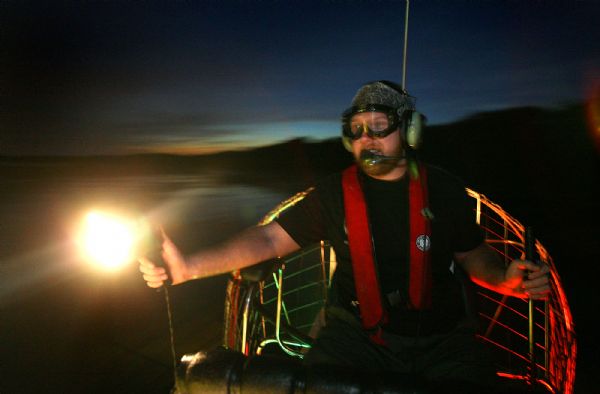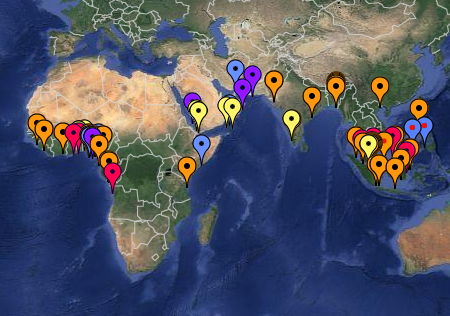biologists count alligators with airboats
posted: 8 June 2012
by: Dinah Voyles Pulver
DELEON SPRINGS — From his perch high atop an airboat seat, Patrick Delaney scanned the surface of Lake Woodruff, shining a bright light across the water’s surface to pick up pairs of eyes glowing orange in the night darkness.
“Six to seven, five to six, five one to twos,” he called to a passenger making tally marks on a computer tablet. Surprised by the light, large alligators rolled into the water with long and powerful splashes that bounced against the boat.
Others hissed and showed no fear, all part of the excitement for Delaney as he estimated the length of every alligator he could spot on the lake.
The Florida Fish and Wildlife Conservation Commission biologist traversed back and forth across Lake Woodruff and neighboring Spring Garden and Mud lakes for five hours on Monday night. He and other commission biologists have pulled similar shifts on lakes across Florida several nights a week since the first of May.
The yearly alligator surveys, which will wind up next week, serve as a cornerstone of the agency’s program to manage the state’s largest native reptile.
Commission officials run the alligator program with a complex mission of ensuring alligator populations continue to thrive without becoming too much of a danger for the people who live nearby and sometimes share the same space. The annual surveys are one of the tools the commission uses to decide how many alligators hunters will be allowed to kill during the state’s annual harvest.
The surveys also are a favorite task for Delaney, who wanted to work with alligators from the time he was about 5 years old.
“Most biologists that work with the FWC enjoy being able to be outside,” Delaney said. “Getting to see alligators is a huge perk of the job.”
Statewide, commission biologists count alligators in about 120 areas each year, Brunell said. The areas, known as alligator management units, are the boundaries assigned for the annual alligator hunt. The St. Johns River and Lake Okeechobee, for example, are each broken up into several management units.
In Volusia and Flagler counties, the biologists survey nine waterways, including Crescent Lake, other lakes along the St. Johns River and lakes Beresford, Ashby and Dias, said Arnold Brunell, a biologist in the commission’s alligator management section.
For beginners, the task of counting alligators might seem a bit daunting. Gauging the accurate length of an alligator in the daytime seems hard enough, much less at night while moving on an airboat or motorboat. But over time, in the more than 30 years since the surveys began, state wildlife biologists said they have honed the skill of estimating size.
The biologists use a variety of clues, including the distance between the orange-glowing orbs, the size of the head and the alligator’s movements.
“You can use all of them to make an educated guess,” Delaney said. And sometimes, the alligators don’t move and the airboat can glide by the alligator and peer down at its full-length through clear water or see it pulled up on the bank.
Delaney said he learned field research from “the best” after he began volunteering with the commission’s alligator section when he was 19, an opportunity he held onto through four years of college at Florida State University. After graduation in 2006, he was able to parlay the degree and his four years of field experience into a job with the commission.
Before he began conducting surveys on his own, he rode along on many surveys with commission biologists John White, now retired, and Brunell, a 23-year veteran, getting a feel for how the process works.
“You ride up front for a whole bunch of surveys,” he said, “Then, they start quizzing you, so you start to calibrate your sizing.”
Florida biologists have conducted the surveys since 1971, extrapolating total population estimates and trends for water bodies based on the number of alligators observed during the surveys, while taking into consideration variables such as fluctuating water levels, weather conditions and habitat types.
Surveys are done during peak breeding season, when the water begins to warm and alligators begin moving around more. The surveys take place at night, Brunell said, because alligators are more active then and are more easily seen by the light reflecting from their eyes.
Each survey takes place in the same standardized fashion, “so someone else can repeat it,” and are often repeated twice in a season to calibrate the results, Delaney said. Agency biologists have evaluated the surveys over time, comparing results with other studies to try to make sure their methods for estimating size work. They’ve also refined the method used to turn the survey data into estimates of alligator populations on waterways.
On Monday night in Lake Woodruff, Delaney tallied 408 alligators.
The night surveys give biologists a chance to see the alligators up close in their element
Delaney’s light surprised one alligator leaping into the air. “You don’t see that all the time,” Delaney said.
Another alligator floated in the midst of a school of fish jumping all around it.
“I bet he’s filling up on fish,” Delaney said. He encountered a few females lingering near their nests and one tiny alligator venturing out into deeper water, a territory normally claimed by much larger adults. As he motored in close to one nest, a female hovered at the bank hissing in protest.
“I just think one of the really neat things about alligators is how well they’re adapted to survive,” he said. “Everything they do is based on instinct. They’re pre-programmed right when they hatch out of the egg to do everything right.”















